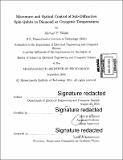Microwave and optical control of sub-diffraction spin qubits in diamond at cryogenic temperatures
Author(s)
Walsh, Michael P., Ph. D. Massachusetts Institute of Technology
DownloadFull printable version (11.99Mb)
Other Contributors
Massachusetts Institute of Technology. Department of Electrical Engineering and Computer Science.
Advisor
Dirk R. Englund.
Terms of use
Metadata
Show full item recordAbstract
Efficient entanglement of negative nitrogen vacancy (NV) centers in diamond will bring us significantly closer to realizing a large scale quantum network, including the design and development of quantum computers. A central requirement for generating large-scale entanglement is a system that can be entangled at a rate faster than it decoheres. There are a variety of proposed protocols to implement entanglement, however, thus far implementation of a system that performs efficiently enough in practice to overcome decoherence has been unsuccessful. In this thesis, I laid the ground work to entangle two NVs using a dipole coupling protocol, a protocol that has the advantageous property of not requiring use of identical photons, making this experimental approach highly feasible. The actual experiment will be done at cryogenic temperatures, a condition that provides an advantage over room temperature realizations of the protocol by extending coherence time and improving readout speed and fidelity. The ultimate goal of this work is to determine if this is achievable in a scalable architecture that will establish a foundation for future experiments in this research and development area.
Description
Thesis: S.M., Massachusetts Institute of Technology, Department of Electrical Engineering and Computer Science, 2015. Cataloged from PDF version of thesis. Includes bibliographical references (pages 87-91).
Date issued
2015Department
Massachusetts Institute of Technology. Department of Electrical Engineering and Computer SciencePublisher
Massachusetts Institute of Technology
Keywords
Electrical Engineering and Computer Science.